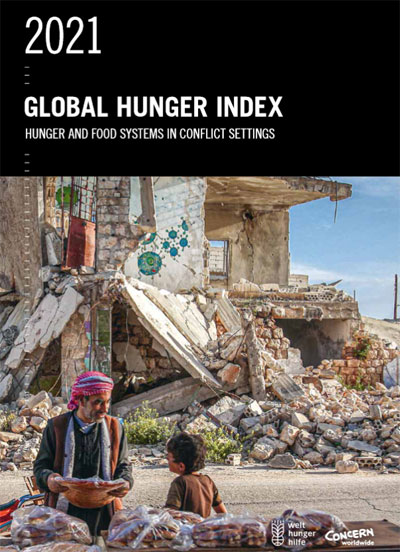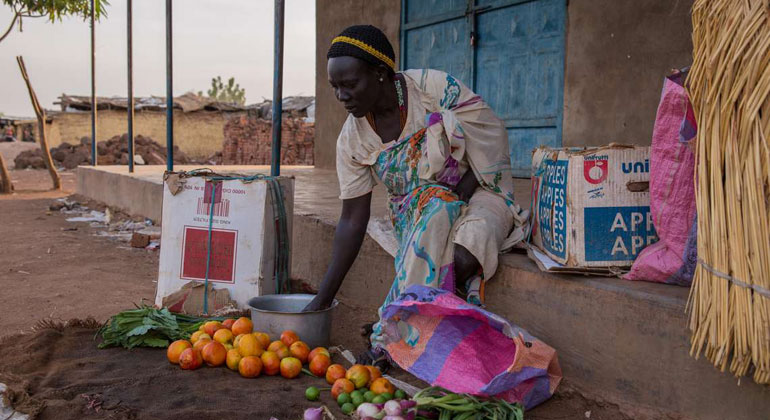Global Hunger Index
What do we know about the hunger situation worldwide? Has progress been made or are there any setbacks? Using the Global Hunger Index, the global hunger situation can be calculated and assessed.
The Global Hunger Index (GHI) is a tool designed to comprehensively measure and track hunger and undernutrition at global, regional, and national levels. It is designed to raise awareness and understanding of the fight against hunger, and call attention to those areas of the world where hunger levels are highest and where the need for additional efforts to eliminate hunger is greatest.
Global Hunger Index 2021: Progress and Setbacks
The 2021 GHI highlights a worrying hunger situation arising from the devastating web of effects of the climate crisis, the COVID-19 pandemic, and increasingly severe and protracted conflicts. Previous progress in the fight against hunger has been slowed or even reversed. Whilst global hunger has declined since 2000, in many countries, progress toward Zero Hunger has stagnated or even experienced setbacks. Hunger has increased in ten countries with moderate, serious, or alarming hunger levels since 2012; in some cases as a result of a lack of progress and in others by worsening an already precarious situation. 14 countries, however, have achieved significant improvements of their hunger situations.
Global hunger, represented by a GHI score of 17.9, is in the moderate category. Twenty years ago, the global hunger situation was still ranked as serious with a score of 28.0. However, too many people around the world still suffer from hunger. In fact, the global prevalence of undernutrition, one of the GHI’s four indicators, is rising again after decades of decline. This trend could be a sign that other hunger indicators are also reversing. We also lag far behind in the global Sustainable Development Goals (SDGs) on child nutrition. Most countries are not on track to meet their goals in reducing wasting (a sign of acute undernutrition), stunting (a sign of chronic undernutrition), as well as under-five child mortality by 2030.
Crises, Conflicts and Climate Change Hinder Zero Hunger
The 2021 Global Hunger Index shows that 47 countries are unlikely to achieve even low levels of hunger by 2030 based on their recent trends. More than half of the undernourished live in countries affected by conflict, violence or in fragile states. Conflict is a major contributor to hunger in eight out of ten countries with serious or alarming hunger levels. Conflicts are particularly devastating for children, driving up malnutrition and child mortality. They can also exacerbate food insecurity through negative impacts on agricultural production, whilst increased food insecurity can in turn contribute to violent conflict.
The impacts of climate change are also becoming increasingly evident, exacerbating food insecurity through higher temperatures, changing precipitation patterns, and more frequent extreme weather events. The COVID-19 pandemic has exposed how vulnerable we are to the global spread of infection and the associated health and economic consequences. By the end of 2020, up to 811 million people were suffering from chronic hunger, and another 155 million people were affected by an acute food crisis. This development is particularly worrying because we are observing an increase without the full impact of the pandemic being included in the data collection. A further increase in hunger can therefore be expected in the future.
Hunger and Food Systems in Conflict Areas
In the context of the 2021 UN Food Systems Summit, the GHI explores one of this year’s key policy questions: How can we bring about crucial change for the millions of people suffering from the devastating effects of conflict and the climate crisis?
Hunger and Food Systems in Conflict Areas
In the context of the 2021 UN Food Systems Summit, the GHI explores one of this year’s key policy questions: How can we bring about crucial change for the millions of people suffering from the devastating effects of conflict and the climate crisis?
Violent conflict is the main cause of food crises. It is destructive to virtually every aspect of a food system, from production, harvesting, processing, and transport to input supply, financing, marketing, and consumption. In many cases, the impacts of conflict and climate change overlap and exacerbate risks to communities. Building resilient food systems must integrate peacebuilding and vice versa. Conflict must be resolved through political action as well as social change, and accountability for violations of the right to food must be ensured in conflict situations. Most urgently, we need global solidarity to adequately respond to and overcome the current pandemic and future global crises.
Where is the hunger situation the most severe?

This year’s Global Hunger Index shows that the hunger situation in many countries still needs urgent attention. According to the 2021 GHI, one country, Somalia, suffers from an extremely alarming level of hunger. Hunger is at an alarming level in five countries – Central African Republic, Chad, Democratic Republic of the Congo, Madagascar, and Yemen. In some countries, there is not enough data to calculate a GHI score. But based on known data, four other countries – Burundi, Comoros, South Sudan and Syria – have been provisionally categorized as alarming.
The 4 Indicators of the Global Hunger Index
- The share of the population that is undernourished
- The share of children under the age of five who are wasted (i.e. who have low weight for their height, reflecting acute undernutrition)
- The share of children under the age of five who are stunted (i.e. who have low height for their age, reflecting chronic undernutrition)
- The mortality rate of children under the age of five
- Global Hunger Index Website | The latest figures, an interactive map and all past GHI reports. Visit the Global Hunger Index Website
- Global Hunger Index 2021 (pdf)
- Global Hunger Index 2021 (Synopsis








